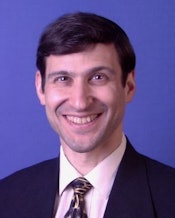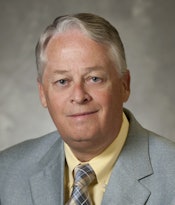
The number of adverse MRI events continues to be a serious issue for imaging centers and radiology departments, despite mandates and guidance to implement MRI safety measures from organizations such as the American College of Radiology (ACR) and the Joint Commission.
There has been a dramatic increase in adverse MRI events in recent years, from 40 reported adverse events in 2004 to 164 reported events in 2012, according to a review of the U.S. Food and Drug Administration's (FDA) Manufacturer and User Facility Device Experience (MAUDE) database.
 Dr. Emanuel Kanal, director of MR services at the University of Pittsburgh.
Dr. Emanuel Kanal, director of MR services at the University of Pittsburgh.From 2009 to 2012, the number of reported adverse MRI events fluctuated, from a peak of 194 in 2009 to 169 reported incidents in 2010. The total rose again to 186 reported events in 2011, before declining in 2012.
The number of new MRI scanner installations only doubled between 2004 and 2009, making the increase in adverse events especially bothersome.
"In the history of mankind, has there ever been any [technology] that we released where the more we understood about safety and the more we knew how to control it, the worse our track record was?" asked Dr. Emanuel Kanal, director of MR services at the University of Pittsburgh.
Kanal and fellow MRI safety advocate Tobias Gilk, president of MRI patient safety consultancy and senior vice president at design and architecture firm Rad-Planning, emphatically discounted the idea that the significant rise was due to more fastidious reporting by imaging facilities.
"My gosh, no. The reporting is horrendous," said Kanal, who assisted Gilk in compiling the numbers. "The numbers that we reported are extremely rough estimates ... [and] do not make a literal tip of the iceberg, meaning not even 10% of the events that are actually happening. The number of actual events could be anywhere from 10 to 100 times greater."
While there are MRI safety training videos, manuals, and best-practice guidelines, Kanal and Gilk contend that the problem is a lack of programs to train technologists and radiologists about their roles in MRI safety. They also advocate the cultivation of MRI safety officers and directors to eliminate flaws in imaging center and radiology department procedures and policies that lead to harmful events.
Burgeoning interest?
 Tobias Gilk, president of MRI patient safety consultancy and senior vice president at Rad-Planning.
Tobias Gilk, president of MRI patient safety consultancy and senior vice president at Rad-Planning.Interest in MRI safety training may be growing, if the duo's MRI safety seminar in June is any indication. "I think we awakened a sleeping giant," Kanal said. "We were hoping to get between 30 and 50 people for the first course, but instead we got about 150 people."
The demand prompted Kanal and Gilk to expand next year's event to three days. They will also host an MRI safety seminar this September in Washington, DC, and the International Society for Magnetic Resonance in Medicine (ISMRM) has scheduled a three-day forum on MRI safety to take place immediately prior to the Kanal-Gilk event.
The pair took an informal poll at their June forum to see how many facilities had an MR safety officer. The response was that almost no sites had such a position.
"When we asked them why they don't have a safety officer for MR, the answer was embarrassingly obvious," Kanal said. It's "because no one felt comfortable or competent to take on that job."
Weighty responsibility
One person who did take on the responsibility of overseeing MRI safety is Wendy Stirnkorb. She is the manager and MRI safety officer for the MRI center at University of Chicago Medicine (UCM). She has held those positions for the past six months and served in the same capacity at the Mayo Clinic for the preceding seven years.
 Wendy Stirnkorb, MRI imaging center manager and safety officer at University of Chicago Medicine.
Wendy Stirnkorb, MRI imaging center manager and safety officer at University of Chicago Medicine.Her duties include ensuring that all non-MRI personnel are appropriately screened and trained for MRI safety prior to entering the area, all patients are properly screened and cleared for scanning, and technologists are educated, trained, and informed about their craft, Stirnkorb said.
She began her imaging career as a front-line MRI technologist and earned a bachelor's degree in radiological sciences from the University of South Alabama.
"Being a registered MRI technologist helps me to be a better MRI department manager because of my understanding of the clinical, technical, and patient care aspects that are uniquely specific to the MRI environment," she added. "Without that knowledge, I would not be as effective."
Her wealth of MRI safety knowledge was acquired through formal education and self-study -- reading, on-the-job experiences, and attending professional safety seminars.
While Stirnkorb certainly deserves great credit for advancing her own expertise in MRI technology and safety, her self-motivation illustrates the aforementioned lack of organized training programs. In-depth MRI safety training, she said, "isn't a standard expectation for MRI imaging managers, nor is it a part of any formal management structure for MRI departments."
ACR has advocated for the creation of MRI safety officer positions since 2002. Its most recently published guidance paper encouraged facilities to train and designate someone as a medical director for MRI safety. As part of ACR's accreditation process, the supervising physician would design and implement an MRI safety program and select an MR safety officer or director (Journal of Magnetic Resonance Imaging, March 2013, Vol. 37:3, pp. 501-530).
"Because equipment is becoming more sophisticated, facilities in general are recognizing the importance of safety issues for all imaging areas, not just MR," said Leonard Lucey, general counsel and senior director for the ACR. "Safety and quality are becoming keystones to a good program."
 Leonard Lucey, general counsel and senior director for the ACR.
Leonard Lucey, general counsel and senior director for the ACR.Despite noble intentions, that there is some reluctance among many professionals to take on the added duties of overseeing MRI safety, Lucey acknowledged.
"I think, with anything in medicine, everyone probably feels a little bit overworked and no one in particular wants to take on extra responsibility and be designated specifically as MR safety director," he said.
In addition to the workload issue, potential candidates are sometimes spooked by the legal ramifications of holding such a position, if something were to go wrong. What many radiologists don't know is that if they read and report a study, they already are legally responsible for the safety of the exam.
"It is so critical that people understand that the radiologist is responsible for the safe execution of an MRI examination, not just its interpretation; that is completely unknown to radiologists in the U.S.," Kanal said. "If you scan a patient as a technologist and as a radiologist, you have already undertaken the legal exposure."
Culture of fear
UCM's Stirnkorb said overcoming a "culture of fear" is the biggest challenge she faces in her positions.
"There is the fear the technologists have of making an error in judgment, fear of not knowing all they should about the safety of a specific device, and fear of having a patient hurt or themselves hurt, because a non-MRI person entered the MRI magnet room behind them," she said. "All of these fears are justified. By having a standard training practice, with tools to provide guidance to the technologists and tools to provide a safe environment, some of those fears can be alleviated."
To address such fears, Stirnkorb created a decision tree to guide UCM technologists through a list of their safety concerns and to think through the process of providing safe MR imaging.
In addition, she recommends that MRI safety officers help educate radiologists and technologists on the safety implications of scanning an individual patient.
"While there is no 'one size fits all' for MRI safety, there are opportunities for standardization through formal policies, decision trees, and documented evidence-based practice, so departments do not have to reinvent the wheel for each patient," Stirnkorb said.
Around the world, several international organizations have taken steps to standardize MRI safety guidelines and requirements.
ISMRM is working with several European societies on a document that will contain recommendations for managing MRI safety. Fernando Calamante, PhD, from the Florey Institute of Neuroscience and Mental Health in Australia, said the document is still in the draft stage and not yet ready for release.
In addition, the Institute of Physics and Engineering in Medicine (IPEM) has recommended that all organizations that use an MRI scanner to image human subjects should engage the services of a qualified MRI safety expert. The policy statement also defines the knowledge and competencies the person should possess.
"I think we are seeing the very beginning of the efforts of an international attempt to standardize an organizational structure on MR safety for every institution," Kanal said.
"As MRI professionals, we must always remember that our first allegiance is to our patients," Stirnkorb added. "We have to ensure that the tools are present for safe patient care. The greatest safety feature in any MRI department is a well-trained, well-educated, diligent MRI professional with solid communication skills."



.fFmgij6Hin.png?auto=compress%2Cformat&fit=crop&h=100&q=70&w=100)




.fFmgij6Hin.png?auto=compress%2Cformat&fit=crop&h=167&q=70&w=250)











